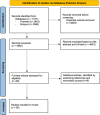Exploring easily accessible neurophysiological biomarkers for predicting Alzheimer's disease progression: a systematic review
- PMID: 39497149
- PMCID: PMC11533378
- DOI: 10.1186/s13195-024-01607-4
Exploring easily accessible neurophysiological biomarkers for predicting Alzheimer's disease progression: a systematic review
Abstract
Alzheimer disease (AD) remains a significant global health concern. The progression from preclinical stages to overt dementia has become a crucial point of interest for researchers. This paper reviews the potential of neurophysiological biomarkers in predicting AD progression, based on a systematic literature search following PRISMA guidelines, including 55 studies. EEG-based techniques have been predominantly employed, whereas TMS studies are less common. Among the investigated neurophysiological measures, spectral power measurements and event-related potentials-based measures, including P300 and N200 latencies, have emerged as the most consistent and reliable biomarkers for predicting the likelihood of conversion to AD. In addition, TMS-based indices of cortical excitability and synaptic plasticity have also shown potential in assessing the risk of conversion to AD. However, concerns persist regarding the methodological discrepancies among studies, the accuracy of these neurophysiological measures in comparison to established AD biomarkers, and their immediate clinical applicability. Further research is needed to validate the predictive capabilities of EEG and TMS measures. Advancements in this area could lead to cost-effective, reliable biomarkers, enhancing diagnostic processes and deepening our understanding of AD pathophysiology.
Keywords: Alzheimer disease; Biomarkers; Electroencephalography; Event-related potentials; Neurophysiology; Transcranial magnetic stimulation.
© 2024. The Author(s).
Conflict of interest statement
The authors declare no competing interests.
Figures
References
-
- Gustavsson A, Norton N, Fast T, Frölich L, Georges J, Holzapfel D, et al. Global estimates on the number of persons across the Alzheimer’s disease continuum. Alzheimer’s Dement. 2023;19:658–70. - PubMed
Publication types
MeSH terms
Substances
LinkOut - more resources
Full Text Sources
Medical
Miscellaneous


